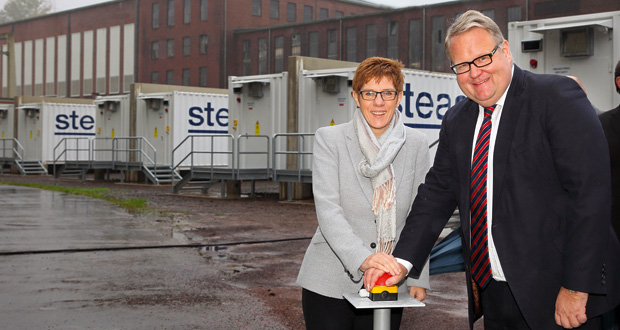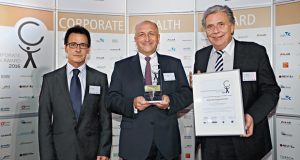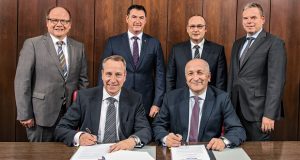The large battery systems of STEAG GmbH in Essen/Germany were officially commissioned in mid-November 2016 with two ceremonies in Quierschied-Weiher and Duisburg-Walsum. Together with Minister-President Annegret Kramp-Karrenbauer, Joachim Rumstadt, Chairman of the Executive Board at STEAG, pressed the symbolic red button at the power station in Weiher, Saarland (Figure 1). This means that the three systems in Bexbach, Fenne and Weiher are now available to compensate for fluctuations in the power grid. The official commissioning of the three additional locations then took place in North Rhine-Westphalia on 17th November. During the opening ceremony in Duisburg-Walsum, NRW Minister of Economics Garrelt Duin performed the symbolic act together with Joachim Rumstadt.
In her speech Kramp-Karrenbauer said: “The large battery system project serves as a sign that STEAG is at the cutting edge of technological progress.” She also welcomed the initiative for securing grid stability.
NRW Minister of Economics Duin was also keen to stress the significance of the project in Duisburg: “The battery storage system makes an important contribution to managing the change in energy policy: Not only does it stabilise the power grid and increase the reliability of supply, it also allows emissions to be reduced through a reduction in the use of fossil fuels. In the current energy environment, which is characterised by powerful dynamic forces of change, we truly welcome the investment of STEAG – particularly since the project was implemented without subsidies. It shows that good ideas can quickly be developed to market maturity through decisive action.”
Rumstadt was also keen to stress: “Grid stability, and the reliability of supply associated with this, is currently the most important factor for successfully managing the change in energy policy. The power grid is being subjected to increasing levels of stress as a result of the ever greater proportion of volatile electricity from renewable energy sources. I am proud that we are not only the technological pioneer with our large battery system, but also that we were able to make our investment on a market basis, i.e. without any public funding.”
To date, the so-called primary control for equalising grid fluctuations has primarily been performed by conventional power stations. For the first time ever, STEAG has now made it possible for large battery systems to perform this same task. Their systems compensate for frequency fluctuations in the grid within seconds by feeding in energy when the frequency is too low or extracting energy when the frequency is too high. The largest battery system in Germany was up and running within just twelve months following the investment decision.
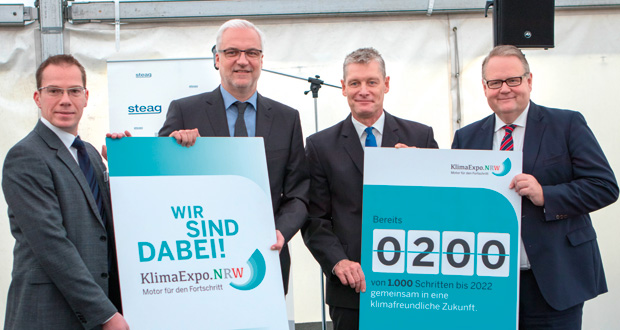
Fig. 2. During the opening ceremony in Duisburg-Walsum, NRW Minister of Economics Garrelt Duin (second from left) and KlimaExpo.NRW CEO Heinrich Dornbusch (second from right) presented the KlimaExpo award to Joachim Rumstadt, Chairman of the Executive Board at STEAG GmbH (right) and project manager Christian Karalis (left). // Bild 2. Beim Festakt in Duisburg-Walsum überreichte NRW-Wirtschaftsminister Garrelt Duin (2. v. l.) gemeinsam mit KlimaExpo.NRW-Geschäftsführer Heinrich Dornbusch (2. v. r.) die Auszeichnung der KlimaExpo an Joachim Rumstadt, Vorsitzender der Geschäftsführung der STEAG GmbH, (r.) und Projektleiter Christian Karalis (l.). Photo/Foto: STEAG
Within the scope of the event in Duisburg-Walsum, the large battery system supplied by STEAG was also qualified as a reference project for the KlimaExpo.NRW climate exhibition. Rumstadt accepted the “We are on board” certificate of the State Climate Protection Initiative in Duisburg from Duin and KlimaExpo.NRW CEO Heinrich Dornbusch (Figure 2). Dornbusch also believes the project has great potential: “The STEAG system not only makes an important contribution to guaranteeing grid stability and reliable energy supply. We also see further potential applications for battery systems, both for performing system services within the scope of the change in energy policy and for cost optimisation and risk management at industrial locations. It is therefore clear that this project should be included in the exhibition as an ‘engine for driving climate protection’.”
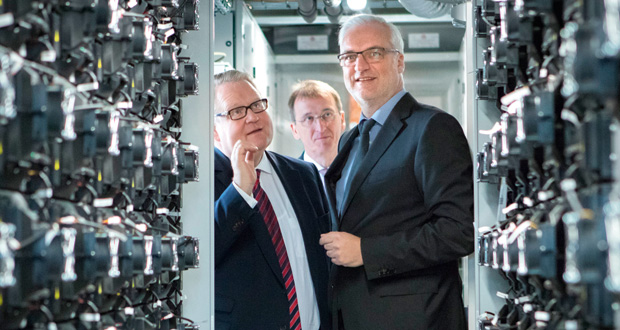
Fig. 3. At the STEAG power station in Duisburg-Walsum, NRW Minister of Economics Garrelt Duin (on the right) listened to an explanation of how the large batteries work by Joachim Rumstadt (Chairman of the Executive Board at STEAG GmbH, shown on the left) and Wolfgang Cieslik (centre), a member of the management team at STEAG GmbH. // Bild 3. NRW-Wirtschaftsminister Garrelt Duin (r.) ließ sich am STEAG-Kraftwerk Duisburg-Walsum das Innenleben der Großbatterien von Joachim Rumstadt (l.), Vorsitzender der Geschäftsführung der STEAG GmbH, und Wolfgang Cieslik (M.), Mitglied der Geschäftsführung der STEAG GmbH, erläutern. Photo/Foto: STEAG
STEAG began preparations for implementation of the six large battery systems with a total output of 90 MW in November 2015 (Figure 3). The total investment was around 100 m €. All work was completed on schedule and within budget in collaboration with the suppliers Nidec ASI and LG Chem.
The large batteries are deployed and marketed via the “STEAG OneOpt” optimization network through the Trading & Optimization division at STEAG. With the investment in this new and innovative technology, STEAG is making a contribution towards implementing Germany’s change in energy policy. (STEAG, Si.)
